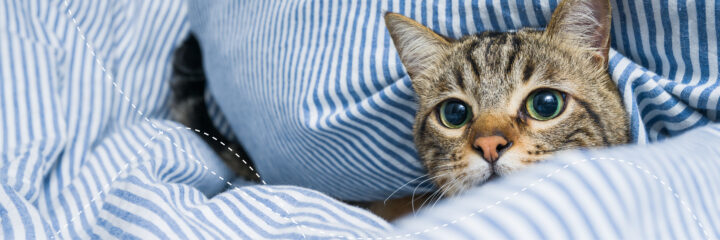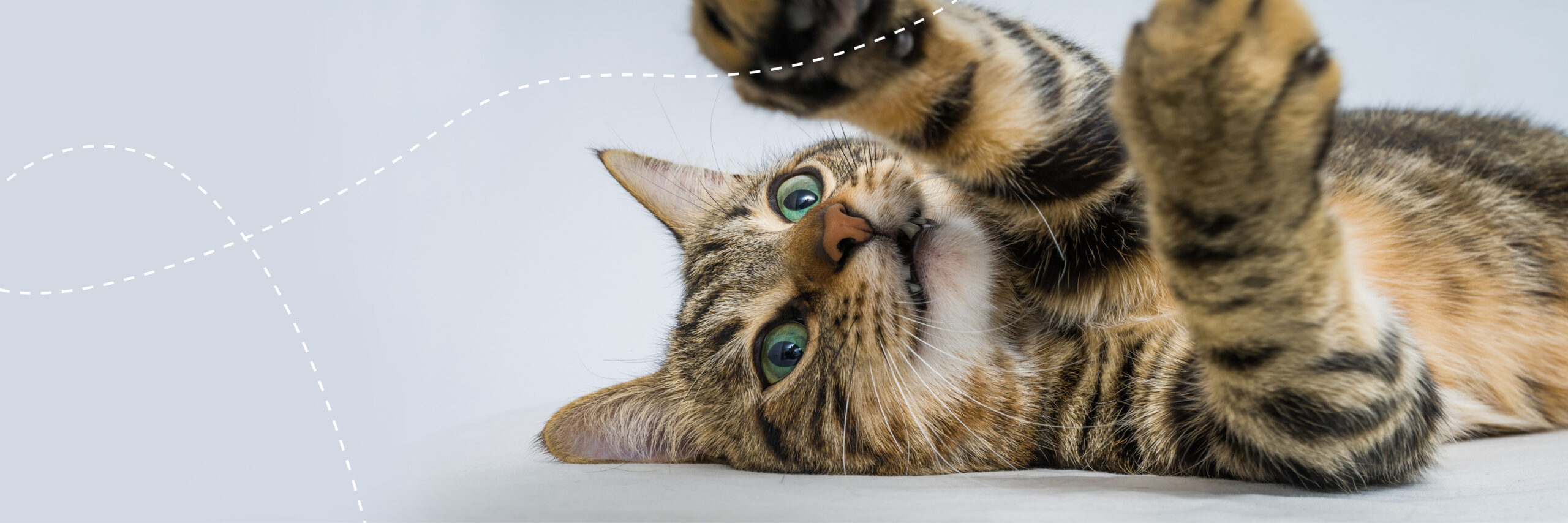
Cats with chronic kidney disease (CKD) develop azotaemiaIncreased levels of nitrogen-containing breakdown products of protein metabolism in the blood.... and, in later stages, uraemiaA raised level in the blood of urea and other urinary substances, which in chronic kidney disease can no longer be adequately excreted due to impaired renal function (glomerular filtration rate). This leads to renal damage due to uraemic toxins, toxic urinary substances The symptoms.... What exactly are these conditions and how do they differ?
Kidney dysfunction
In the context of chronic kidney disease, azotaemia refers to an increase in the blood levels of the “kidney markers” creatinineCreatinine is a breakdown product of muscle metabolism. Its blood level is dependent, among many factors, on age, weight, nutritional status and muscle mass. Hence, creatinine levels in the blood vary from individual to individual. Creatinine is continuously excreted in the urine. Increased blood creatinine... and/or ureaUrea is the nitrogen-containing breakdown product of protein metabolism. The nitrogen from the proteins is converted to ammonia in the liver, which is combined with carbon dioxide to form urea. This is continuously excreted via the kidneys but also via sweat. Urea is one of.... There may be an increase in both or only one of the two. Azotaemia shows the dysfunction in relation to the excretory capacity of the kidneys.
Blood marker
Creatinine
Creatinine, which is also used by the international expert group of the International Renal Interest Society (IRIS) as a key marker for diagnosis and staging= Classification of the cat into a stage of chronic kidney disease according to IRIS..., is representative of the excretory capacity in the form of glomerular filtration of the kidneys. Creatinine from muscle metabolism is filtered out of the blood by the renal corpuscles (the filtration unit of the nephron, also called the glomerulus). This takes place in the glomerulus and is therefore known as glomerular filtration. If this filtration is inadequate, less creatinine is filtered out of the blood and so builds up in the blood. This causes the blood creatinine level to rise. Increased creatinine indicates impaired excretion.
Creatinine has a very wide normal range. Cats therefore have an individual reference value. Some cats that have a 15-20% increase in their creatinine level, indicating a kidney problem, may still have a creatinine level within the normal range. Having the cat tested annually to know this individual creatinine level is therefore very beneficial. Only then can incipient CKD be detected at an early stage by the above mentioned increase in blood creatinine. Nowadays it is easier to use SDMASDMA = Symmetrical Dimethylarginine, which is a degradation product of the amino acid arginine and is excreted solely through the kidneys. SDMA is a highly specific biomarker for kidney function in cats. Read more: SDMA test (blood test).... SDMA rises earlier than creatinine when the kidneys are not working as well as they should. Creatinine also depends on the cat’s muscle mass and eating habits: If the muscle mass in CKD is decreasing, for example because the cat is not eating enough (protein), the creatinine level will be lower, giving the impression that the situation is better than it actually is. This is not the case with SDMA as it is independent of muscle mass.
Urea
Urea is a waste product of protein metabolism and is also filtered out of the blood via the glomerulus. However, unlike creatinine, it can be reabsorbed from the subsequent tubular system. An increase in urea may initially be related to an increased protein intake. This will result in the production of more urea and an increase in the blood urea level.
If the cat is dehydrated and urine output is therefore reduced, blood urea may be elevated. With high water loss, such as that associated with CKD, the recovery of urea from the tubular system may be reduced, resulting in a lower blood urea level than would be expected for the CKD stage.
Lack of appetite and low protein intake may also reduce urea levels. However, an elevated urea level represents uraemia, especially in the later stages of CKD.
Find out more about the blood tests for CKE here.

Kidney dysfunction and its clinical consequences
Uraemia is the term used to describe the clinical consequences (symptoms) of reduced kidney function, which includes detoxification and excretion, water and electrolyte regulation, acid-base balance and hormone production. The kidneys also regulate blood pressure (reninA hormone-like enzyme, generated and stored in the kidneys. If blood pressure drops, it is released from the kidneys and is highly efficient in raising blood pressure.... hormone), haematopoiesis (erythropoietinErythropoietin, abbreviated to EPO, is a growth factor that stimulates red blood cell production. EPO can be produced biotechnologically and administered for kidney failure or after chemotherapy.... hormone) and phosphate and calcium metabolism (calcitriolCalcitriol is the active form of vitamin D3. It is synthesised in the kidney from vitamin D. It is independently activated by three factors: increased parathyroid hormone levels, reduced calcium levels or indirectly via reduced phosphate levels. Calcitriol acts on four organs: 1) Bones: It... hormone) through the three hormones they produce. All of these functions are impaired in CKD. This is manifested in a variety of ways, including changes in laboratory values and the appearance of clinical symptoms.
FGF-23: a new player on the field?
FGF-23 has recently been discussed as a laboratory parameter in relation to uraemia. It participates in regulating plasma phosphate levels. Even when phosphate excretion is restricted due to glomerular damage and failure, FGF-23 can keep the phosphate level within the normal range. This parameter may therefore be useful in deciding whether and to what extent phosphate reduction (via diet and/or phosphate binders) is indicated. At present, FGF-23 is not a routine laboratory test when cats are blood tested for renal parameters.
A villain from within
The situation is different with indoxyl sulphate. This uraemic toxin is a natural product of the microbial breakdown of the amino acid tryptophan. Tryptophan is found in plants and in the meat of herbivorous animals (cattle, sheep, goats, poultry, etc.).
Tryptophan is broken down by the natural intestinal flora in the large intestine. In the process, indole is formed as a precursor. This is transported via the bloodstream to the liver, where it is converted into indoxyl sulphate, the actual uraemic toxin. This uraemic toxin must then be excreted by the kidneys.
10% of the excretion takes place via glomerular filtration and 90% in the tubular system, where it is actively excreted into the urine with the help of a transport system. If both excretion pathways are reduced in CKD, it accumulates in the kidney tissue and causes further damage. This leads to the progression of chronic kidney disease.
In addition, indoxyl sulphate has other adverse effects on the cat’s body: it alters the natural gut flora, causing an imbalance in the bacteria (dysbiosisImbalance of organisms of the the microbiome (all microbes on or within an animal’s tissues), for instance the imbalance of the intestinal flora as part of the microbiome....), resulting in gastrointestinal problems and an additional overproduction of indoxyl sulphate. Indoxyl sulphate is part of the gut-kidney axis, which describes the relationship between changes in the gut microbiota and kidney health, and conversely, the effects of CKD (increased indoxyl sulfate due to inadequate excretion) on the gut microbiota.
Uraemia indicator
In chronic kidney disease (CKD), indoxyl sulphate is involved in many processes that not only cause clinical symptoms (loss of appetite, weight loss, including muscle wasting, vomiting, nausea, diarrhoea) but also promote disease progression. This includes the fact that indoxyl sulphate is known to interfere with phosphate metabolism.
As early as IRIS stage II, higher levels of indoxyl sulphate can be detected in the blood. Indoxyl sulphate levels are highest in stage IV. Efforts to reduce uraemic toxinsToxic, nitrogen-containing urinary substances responsible for uraemia and kidney damage.... should be intensified as the level of indoxyl sulphate increases.
Indoxyl sulphate may have prognostic value for the cat’s clinically relevant condition (degree of uraemia). Routine testing is currently only available in one German laboratory.
Bibliography:
- von Luckner, J. & Stieger, N. (2023). Die urämische Katze. In: Katzenmedizin, 13. 24–27.


